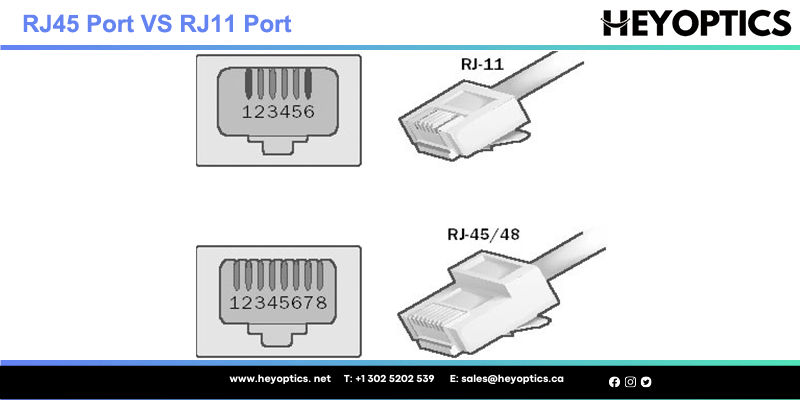RJ45 Port VS RJ11 Port: What is the difference?
Right from the good old days of analog telephones and faxes, cables and connectors have been an integral part of network communication. With the advancements in electronics, internet technologies, and the importance of data communication apart from voice, the demand for private business networks, and subsequently the required devices has only grown. RJ11 jack and RJ45 jack connectors have been there for a very long time, and in fact RJ45 is still used in copper cable data communication networks.This post compares RJ45 vs RJ11 connectors and more.
What is Registered Jack
RJ, which means Registered Jack, is the acronym that cable connectors usually start with,and as the numbers in the terms imply, RJ11 is much older than the later. The numbers 11 and 45 are the interface standards. Connectors using the distinction Registered Jack (RJ) describe a standardized telecommunication network interface. Two of the most common jacks are the RJ45 and RJ11, each with their own specific purpose.
R45 cable connectors VS RJ11 Cable connectors
The following pointers on RJ11 and R45 cable connectors will help you understand it better.
RJ11: RJ11 as discussed before was widely used in analog telephony to connect the phone instrument and the cable. Now it is mostly used to connect to modems and is still used in landlines. It is a 4-slot connector and has six pins, which means you cannot fit it into an RJ45 slot. It is used in PSTN telephone lines to connect telephone cables which are technically different from Ethernet cables.
RJ45: RJ-45 connectors have 8 pins and these are typically used to connect Ethernet cables to a switch or serial data modem. You would commonly find switches with RJ45 connectors in copper cable networks. Some switches have RJ45 as well as SFP fiber ports and hence these can be used in fiber networks as well. So, these are typically used for data communication networks where IP voice telephony may also be there.

Comparative Account: RJ45 Vs RJ11
Here are some pointers regarding the major differences between RJ45 and RJ11:
The primary difference lies in their physical appearance, wherein the RJ45 connecter is broader than RJ 11 and has 8 pins. RJ112 has 6 pins and a narrow plugging end. Their pin colors are different as well.
Since RJ 45 is used in data communication networks using Ethernet cables, it supports 10Gbps bandwidth. This can be further extended using fiber optics such as a fiber cable and a fiber media converter. RJ11 support just 24Mbps bandwidth.
Since RJ45 has 8 pins and connecting ports, it is called 8P8C. On the same lines RJ11 is called 6P4C.
RJ45 connectors commonly connect to Cat5 and Cat6 cables, while RJ11 simply connects to a telephone cable.
RJ45 can connect to various devices in a copper cable network such as switches, cables, computers, routers, and so on.
Switches with RJ11 connectors comprise mainly two sockets for a 2-line telephone system. On the other hand, switches with RJ45 connectors are of various types such as managed or unmanaged network switches 4,5, 8, 10 or even 20 ports. Some switches support fiber connections as well and hence have SFP+ ports on one end and RJ45 on the other. The number of ports may vary.
Conclusion
RJ45 is mostly used with ethernet cables while RJ11 in connecting telephone units.
RJ45 has 8 wires inside while Rj11 has 4 wires.
RJ45 is bigger in size than RJ11.
You cannot plug-in RJ45 cable connector into a RJ11 interface/port/slot however you can do the opposite (you should avoid doing so as it can damage the RJ45 port).
Do you have an existing legacy network which you plan to expand in terms of transmission distance and speed? If yes, it would be wise to blend fiber optics into your existing copper cable network. Heyoptics offers network switches and fiber media converters with RJ45 ports for copper as well as SFP+ ports for fiber.



